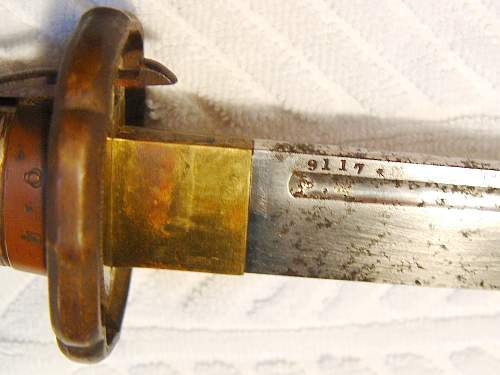The red bean color Saya was no longer supposed to be present by the 1935 launch, so you won't find it on a production Type 95, except possibly as the reddish color used to paint the aluminum grips.
One aspect that definitely changed between the spec approval and production start was the disappearance of the cotton shock-absorbing Saya cover to prevent paint chipping. There is no documentation on why this feature could be dropped, but it is obvious that some kind of breakthrough in the paint was achieved. I suspect something like the advent of chloride rubber paint or phthalic acid paint with a more elastic surface allowed higher shock resistance.
In this connection, 1935 saw the army approving use of the newly developed paint for metal plane propellers and 1937 saw the advent of waterproof paint, oil resistant paint and anticorrosion paint developed mainly for naval aviation, so the paint industry was indeed coming up with some revolutionary stuff around the time of introduction of the Type 95 Sword.
I decided to track down this iron tsuba statement and I believe I have located the source of it. The only book that mentions this is a Japanese military sword book published in 2007. In the Type 95 chapter, the following is stated.
The wording above makes it clear that this is speculation on the part of the author and it is not based on a historical document. The author cites a document from page 146 of a book published in 1990 by Imai Akio 今井・昭夫 and Ikemori Masato 池森・正人. This is the same document that is mentioned above by Nick, namely "Army Regular notice 2962" [昭和16年4月23日, 陸普第2962号]. So far, I have been unable to locate this document.The use of plain iron tsuba to replace the more ornate brass ones may have been the intent of a revision to the Uniform Regulations dated April 23, 1941 (Shōwa 16), that authorized an unspecified change in tsuba design in order to simplify production.8
8 Imai, p. 146.
Works Consulted
Dawson, Jim. Swords of Imperial Japan, 1868–1945. Cyclopedia ed. Newnan, Ga.: Stenger-Scott Publishing, 2007. Page 196.
Imai Akio 今井・昭夫 and Ikemori Masato 池森・正人. Nihon no gun'yō tōken 1868-1945nen 日本の軍用刀剣1868-1945年 [Japanese Military Used Swords, 1868–1945]. Army edition 陸軍編. 2 volumes. Zennihon gunsō kenkyū-kai 全日本軍装研究会, 1990. Page 146.
The strange thing is that the drawing below is supposed to show how the tassel was to be attached to the Type 95 when in combination with the new Tsuba design introduced by notice 2962 of 23rd April 1941, but what is shown does not look like an iron Tsuba at all.
I agree that the illustration is most likely that of a solid brass tsuba. The only reason for doing so would be if the iron tsuba was introduced about the same time. The iron tsuba does not have an opening for the tassel to pass through. Hence the change to the brass tsuba specifications to conform to the possible introduction of the iron tsuba. Also, as pointed out by Stegel in post #47, none of these solid brass tsubas are known to exist. Undoubtedly some were manufactured to show the concept, but the change never occurred on the production line. Both the brass tsuba with tassel opening and the solid iron tsuba were used in production simultaneously. This is merely conjecture on my part and should be taken as such. Only documentation will shed light on what truly happened.
It is difficult to tell exactly when the iron tsuba started being used in new production. The reason for this is that iron tsubas were used during overhauls and/or repairs on early swords. For example, the following early swords have iron tsubas: 1476東, 3422東, 8714東, 名10915, 名16939, 22952東, 26204東, and 29036東. Another reason is that after the war, parts were exchanged, not only by owners, but dealers as well. I will not comment further on this aspect of alterations.
With the above said and out of the way, this is what I can say. By the 50,000 and 60,000 serial number range, iron ferrules and iron tsubas start to show up more frequently. Indicating that the iron parts were supplementing the more traditional parts; but, not replacing them entirely. As the war progressed, these iron parts began to appear in greater quantity. By mid 1944, iron was used almost exclusively, especially by Nagoya and Jinsen Arsenals. The 1st Tokyo Arsenal seems to have suffered a large drop off in production starting in 1944 as pointed out by Nick in post #80. This was followed by production coming to a complete stop in March 1945 because of bombing. See for example post #82.
I suspect that two of those are definite Post War swap outs (that is were originally Brass tsuba's)
I'm with Thomas on an awful lot of post-war swaps to go with genuine period repairs/replacements, so this is a bit of a mine field to cover.
I've been following these for a while and it is particularly hard to determine when the actual roll out of these happened.
Here's two that i think given the condition of the blade/sword, would appear to be older than the photo's you have shown.


Maybe someone changes wartime repaired iron guard to brass guard so can sell for a higher price?
Yes, that is a possibility, but i think it may have happened the other way -from brass to iron tsuba.
These are from August 2018 (#7241) amd May 2014 (#9117).
Do you remember when you got your pictures? That will shed a little light on these two at least.
Similar Threads
Bookmarks